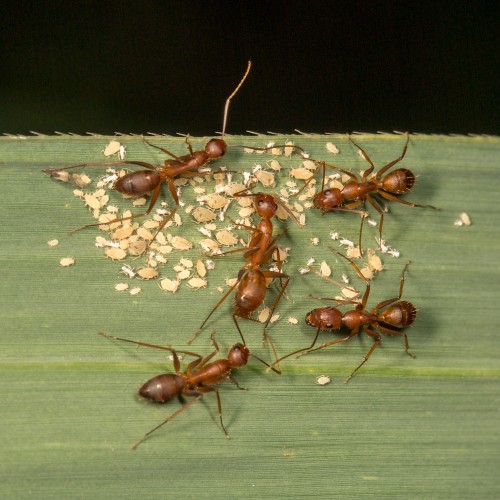
It was raining heavily, I found these few amber colored ants climbing a sugarcane stem which had grown in our garden. They went underneath a leaf and stayed there for a long time. I was curious to find what they were doing. I turned the leaf over and I found these Camponotus Ants on the underside of the sugarcane leaf tending aphids. I used Canon EOS 5D Mark III fitted with Canon EF 100mm f/2.8L Macro IS USM illuminated by Canon MT-24EX macro twin light flash.

They looked like minor worker of giant honey ants (Camponotus irritans). These are ground dwelling ants, they construct nest in soil, rarely in cracks and crevices in buildings and structures. They are polymorphic. The major worker ants measure about 8 to 10 mm in length and the minor worker measure upto 6 to 7 mm. The mesosoma little longer compared with its cousins, in major workers the gaster is dark- reddish brown and shows shining. Where as in minor worker the head and mesosoma are honey colored. The node of the petiole conical in shape, and little convex in anterior and posterior it is flat. These ants in the photograph looks like minor workers. As there are over 13 subspecies of these ants it is a difficult task to identify them. The only resource book I have – On a Trail with Ants by Ajay Narendra & Sunil Kumar M is very sketchy about these sub species.
These ants also “farm” aphids, protecting them on the plants they eat, eating the honeydew that the aphids release from the terminations of their alimentary canals as carbohydrate source. This is a “mutualistic relationship”. These “dairying ants” “milk” the aphids by stroking them with their antennae. Therefore, sometimes aphids are called “ant cows”.

Aphids, also known as plant lice or greenflies, are small plant-eating insects, and members of the superfamily Aphidoidea. Aphids are among the most destructive insect pests on cultivated plants in temperate regions. The damage they do to plants has made them enemies of farmers and gardeners the world over, but from a purely zoological standpoint they are a very successful group of organisms.
The Aphid on this Sugarcane palnt looks like common sugarcane aphid (Melanaphis sacchari). This aphid infests the undersides of leaves, which show red spots, patches, blotches or streaks, later becoming completely red or brown-red. Stems of infested plants are crooked, and heading is affected. The leaf surface is covered with honeydew, leading to mildew or sooty molds. According to the level of aphid damage five effective methods of cultural control against Melanaphis sacchari: improving the soil; irrigation; close planting; applying fertilizer; and enhancing field management by cutting grass in the autumn, when the pests migrate from sorghum to grass to overwinter.

Melanaphis sacchari is a common pest of sorghum in tropical Africa, Asia, the Far East and the Americas. All growth stages can be infested, but economic damage usually occurs during the later growth stages. Sap is sucked from abaxial leaf surfaces, with heavily infested leaves turning prematurely brown. Plants may have stunted growth and poor grain yields. As many as 30,000 aphids may infest a single plant. Despite the lack of objective assessments of crop losses, Melanaphis sacchari is ranked as a major pest of sorghum in East Asia.
In India, Melanaphis sacchari primarily transmits SCMV strain H. A SCMV subgroup of potyviruses causes sorghum red stripe disease in India; a distinct disease-causing sugarcane potyvirus is spread from sugarcane to sorghum by Melanaphis sacchari. Sugarcane yellow leaf syndrome is caused by Sugarcane yellow leaf virus (ScYLV), which is transmitted by Melanaphis sacchari. ScYLV affects many sugarcane-growing areas worldwide, including those in the USA, the West Indies and Colombia.

Update:- I just found out from Dr. Ajaya Narendra who was kind enough to help me, that they are not giant honey ants (Camponotus irritans) but some other Camponotus species and the search is on for the exact id of these ants.


????? ???????????,
? ????? ???? ???(?????????)????? ????? ?????. ?????? ????? ????? ????. ???? ??? ????? ?????? ????????????. ? ??????????? ????? ??????? ????? ??????? ??? ?????. ????? ???????????? ???? ??????? ??????? ???? ????? ??? ???. ? ????? ????? ?????? ????? ???????? ?????????. ???????????????? ? ???????? ????????????. ???????? ???? ????? ?????. ????????? ????? ??????? ??????????? ? ???????? ?????????. ?????? ??? ??????????? ?????????.